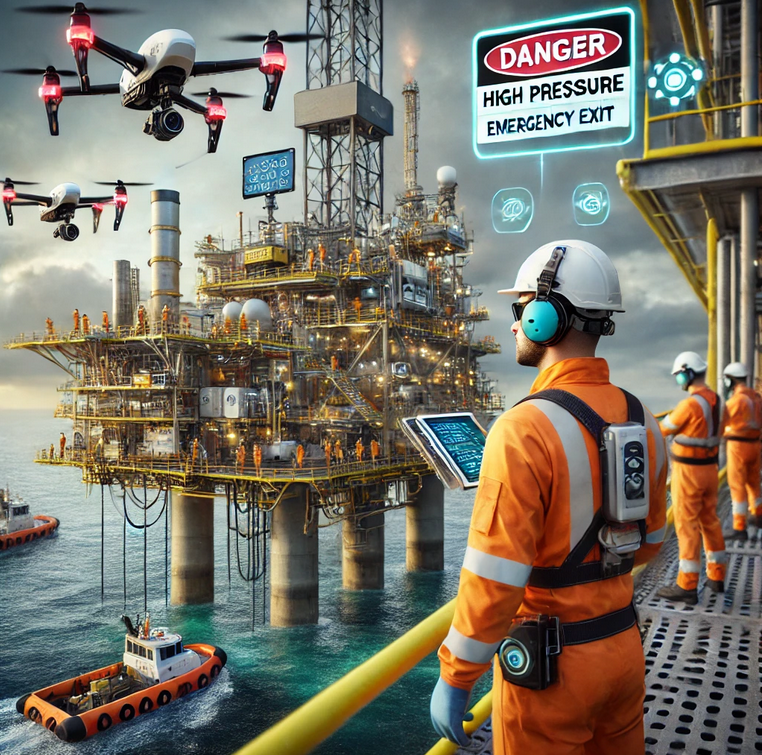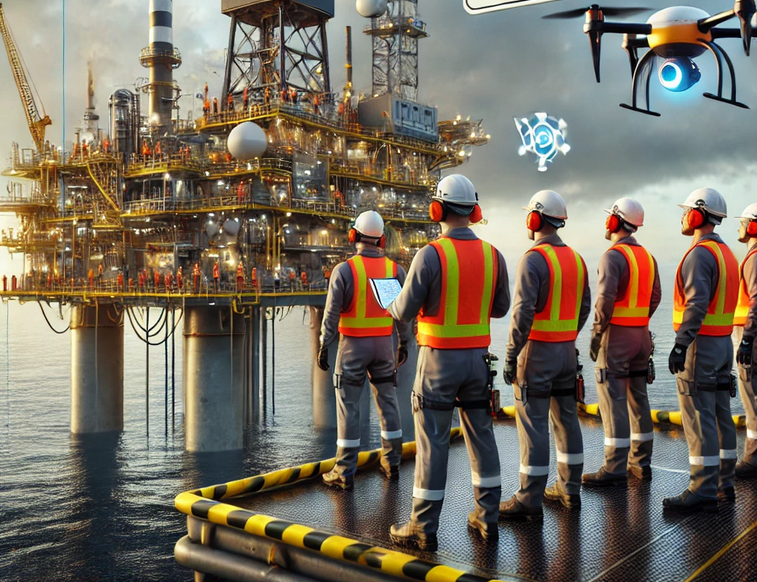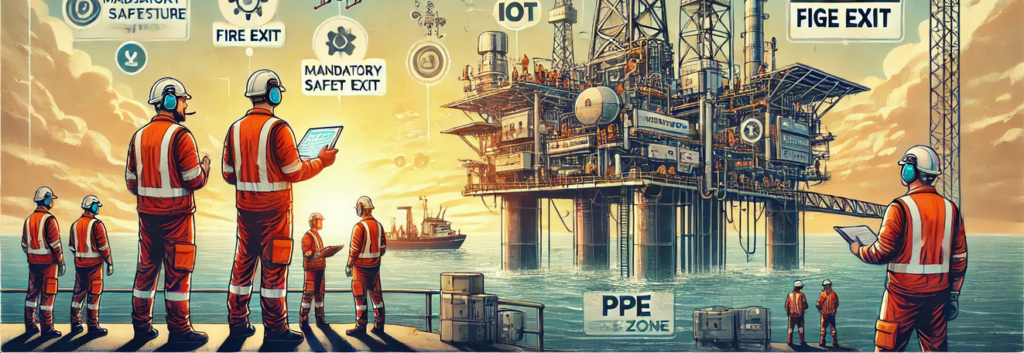Oil and Gas Safety : The oil and gas industry is one of the most vital yet hazardous sectors in the world. With ever-increasing global demand for energy, the industry faces unique safety challenges that require continuous innovation and vigilance.

In this article, we explore emerging risks in the oil and gas sector and highlight best practices for ensuring safety and operational efficiency.
Emerging Risks in the Oil and Gas Industry
The oil and gas sector constantly evolves, introducing new risks to workers, the environment, and surrounding communities. Below are some of the prominent emerging risks:

1. Technological Complexity
The adoption of advanced technologies, including automation, robotics, and artificial intelligence (AI), has transformed operations. However, these technologies also introduce risks such as cyberattacks, system malfunctions, and the need for specialized skills among workers.
For example, cyberattacks on critical infrastructure can result in operational disruptions, financial losses, and even environmental disasters. Training employees on cybersecurity and maintaining robust firewalls and intrusion detection systems are crucial to minimizing these risks.
2. Aging Infrastructure
Many oil and gas facilities operate on aging infrastructure, leading to increased risks of equipment failure, leaks, and accidents.
Pipeline corrosion and outdated safety systems exacerbate these hazards. Recent studies indicate that older pipelines are more prone to rupture, causing oil spills that harm the environment and incur significant cleanup costs.
To address these challenges, organizations must prioritize regular inspections, implement predictive maintenance strategies, and replace outdated equipment. Upgrading infrastructure not only enhances safety but also improves operational efficiency.
3. Climate Change and Extreme Weather
Climate change has heightened the frequency of extreme weather events, including hurricanes, floods, and heatwaves. Such events pose significant operational and safety challenges for offshore platforms and onshore facilities. For instance, hurricanes can damage offshore rigs, leading to oil spills and endangering workers.
Developing climate-resilient infrastructure and adopting advanced weather monitoring systems can help mitigate these risks.
Additionally, organizations should establish contingency plans to respond swiftly to weather-related disruptions.
4. Workforce Challenges
An aging workforce and the global shortage of skilled labor have created gaps in safety expertise. New employees may lack adequate training, leading to higher accident rates. Moreover, the increasing reliance on technology requires workers to possess specialized technical skills.
To bridge this gap, companies must invest in robust training programs, mentorship initiatives, and knowledge transfer strategies.
Empowering employees with the skills needed to navigate modern safety challenges is essential for fostering a safe work environment.
5. Environmental and Regulatory Pressures
Stringent environmental regulations and public scrutiny demand enhanced safety and sustainability practices. Non-compliance can result in severe penalties, reputational damage, and operational shutdowns.
For instance, failing to adhere to emissions standards or mishandling hazardous materials can lead to costly fines and legal repercussions.
By integrating environmental management systems and staying updated on regulatory requirements, organizations can ensure compliance while demonstrating their commitment to sustainability.
| Emerging Risk | Impact | Example |
|---|---|---|
| Technological Complexity | Increased risk of cyberattacks | Hacking of offshore platforms |
| Aging Infrastructure | Equipment failures and accidents | Pipeline corrosion causing oil spills |
| Climate Change | Disruption due to extreme weather | Hurricane damage to offshore rigs |
| Workforce Challenges | Lack of safety expertise | Higher accident rates among new workers |
| Environmental and Regulatory Pressures | Operational shutdowns for non-compliance | Stricter emissions regulations |
Best Practices for Oil and Gas Safety

To mitigate emerging risks, the oil and gas industry must adopt best practices tailored to modern challenges. Here are actionable strategies:
1. Embrace Advanced Safety Technologies
Invest in technologies such as:
- Drones and Remote Monitoring: Drones can inspect pipelines and offshore platforms, reducing the need for human intervention in hazardous areas.
- IoT Sensors: Internet of Things (IoT) sensors monitor equipment conditions in real-time, enabling predictive maintenance.
- Virtual Reality (VR) Training: VR simulations provide immersive safety training for high-risk scenarios, improving worker preparedness.
These technologies not only enhance safety but also improve operational efficiency. For instance, predictive analytics powered by IoT sensors can identify potential equipment failures before they occur, minimizing downtime and preventing accidents.
2. Upgrade Aging Infrastructure
- Conduct regular inspections to assess the integrity of pipelines and equipment.
- Implement corrosion prevention techniques, such as cathodic protection and advanced coatings.
- Replace outdated systems with modern, fail-safe designs.
Investing in infrastructure upgrades is a long-term strategy that yields significant safety and financial benefits. For example, replacing older pipelines with state-of-the-art materials can reduce the likelihood of spills and extend the lifespan of assets.
3. Strengthen Emergency Preparedness
- Develop comprehensive emergency response plans tailored to specific risks, such as oil spills or natural disasters.
- Conduct regular drills to ensure workers are well-prepared.
- Collaborate with local authorities and emergency services for effective coordination.
Emergency preparedness is a critical component of safety management. Companies should also invest in advanced communication systems to ensure timely information dissemination during crises.
4. Enhance Workforce Training
- Provide rigorous onboarding and ongoing training for employees, focusing on safety protocols and the use of new technologies.
- Encourage a culture of safety through leadership and peer accountability.
- Address knowledge gaps caused by workforce turnover with mentorship programs.
Effective training programs can significantly reduce workplace accidents. Incorporating scenario-based learning and hands-on experiences ensures that employees are well-equipped to handle real-world challenges.
5. Prioritize Environmental and Regulatory Compliance
- Implement strict environmental management systems to monitor emissions, waste disposal, and resource use.
- Stay updated on local and international regulations to ensure compliance.
- Engage in transparent communication with stakeholders to build trust.
Adhering to environmental standards not only avoids legal repercussions but also enhances the organization’s reputation. Demonstrating a commitment to sustainability can attract investors and foster community support.
6. Foster a Culture of Safety
- Establish safety as a core value across all levels of the organization.
- Encourage workers to report near-misses and potential hazards without fear of reprisal.
- Reward proactive safety behavior to reinforce positive practices.
Creating a culture of safety requires consistent effort and strong leadership. Organizations should regularly review their safety policies and involve employees in decision-making processes to foster a sense of ownership.
Case Study: Safety Transformation at Offshore Rigs
One notable example of improved safety practices is the implementation of predictive analytics on offshore rigs. By using IoT sensors and AI, a major oil company reduced equipment failures by 40% and improved worker safety. The data collected allowed the company to anticipate issues before they became critical, resulting in fewer incidents and downtime.
In another instance, a company utilized VR training to simulate emergency evacuations on offshore platforms. This approach enhanced workers’ ability to respond effectively during actual emergencies, significantly reducing evacuation times and improving survival rates.
Key Takeaways for Industry Leaders
- Proactive Risk Assessment: Regularly evaluate emerging risks and adjust safety protocols accordingly.
- Invest in Innovation: Embrace technologies that enhance monitoring, training, and emergency response.
- Focus on Collaboration: Partner with industry peers, regulators, and local communities to share best practices and resources.
Conclusion
Safety in the oil and gas industry is a dynamic and evolving challenge. By addressing emerging risks and implementing best practices, companies can protect their workers, the environment, and their bottom line. The road ahead requires a commitment to innovation, collaboration, and a steadfast focus on safety.
Emerging risks in the oil and gas industry demand a proactive and adaptable approach. By prioritizing safety at every level, the industry can navigate challenges and ensure a sustainable future for all stakeholders.
Expanding the focus on technological advancements, workforce development, and regulatory compliance will ensure that the oil and gas sector remains resilient in the face of emerging challenges.


No comments yet